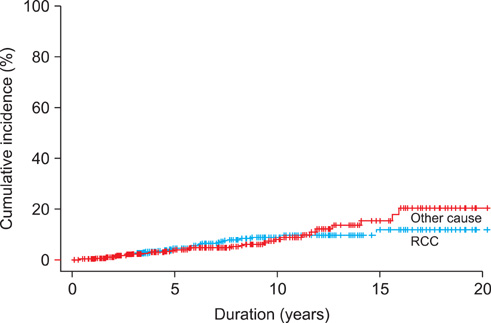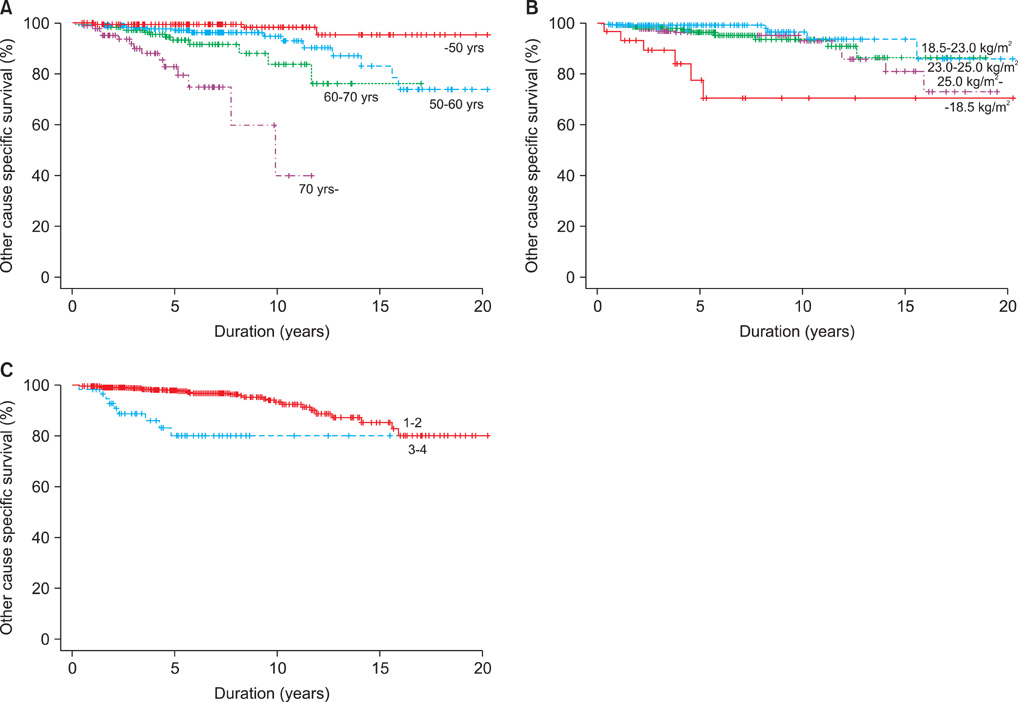Korean J Urol.
2012 Jan;53(1):18-22. 10.4111/kju.2012.53.1.18.
Predicting Factors for Death from Other Causes in Patients with Localized Renal Cell Carcinoma
- Affiliations
-
- 1Department of Urology, Seoul National University College of Medicine, Seoul, Korea. hhkim@snu.ac.kr
- KMID: 1988818
- DOI: http://doi.org/10.4111/kju.2012.53.1.18
Abstract
- PURPOSE
To identify the predictors of death from other causes in patients with localized renal cell carcinoma (RCC).
MATERIALS AND METHODS
We identified 1,101 patients with pathologically confirmed T1 or T2 RCC with a follow-up duration of over 6 months. Survival according to the cause of death was evaluated by using the Kaplan-Meier analysis with log-rank test. Prognostic factors for death from other causes were assessed by multivariate analysis using the Cox proportional hazard regression model. Once the prognostic factors were identified, a risk-group variable was created by counting the number of unfavorable features present for each patient.
RESULTS
The median follow-up was 62 months, and RCC-related death occurred in 50 patients (4.5%), whereas death from other causes occurred in 47 (4.3%). Patients who died from other causes had a higher American Society of Anesthesiologist (ASA) score (26.1% vs. 10.2%; p=0.044), older age (63.4 years vs. 55.0 years; p<0.001), smaller mass size (5.1 cm vs. 7.9 cm; p<0.001), and lower nuclear grade (p=0.003). In the multivariate Cox regression analysis, older age, higher ASA score, and lower body mass index were independent factors predicting death from other causes in patients with localized RCC. On the basis of the number of risk factors for death from other causes, the 5-year other-cause-specific survival was 98.3% (0 risk factors), 84.7% (1 risk factor), and 67.6% (2 or 3 risk factors), respectively (p<0.001).
CONCLUSIONS
Older age, higher ASA score, and lower body mass index were independent predictors of death from other causes in patients with localized RCC.
Keyword
MeSH Terms
Figure
Reference
-
1. Chow WH, Devesa SS, Warren JL, Fraumeni JF Jr. Rising incidence of renal cell cancer in the United States. JAMA. 1999. 281:1628–1631.2. Mues AC, Landman J. Small renal masses: current concepts regarding the natural history and reflections on the American Urological Association guidelines. Curr Opin Urol. 2010. 20:105–110.3. Chawla SN, Crispen PL, Hanlon AL, Greenberg RE, Chen DY, Uzzo RG. The natural history of observed enhancing renal masses: meta-analysis and review of the world literature. J Urol. 2006. 175:425–431.4. Anuurad E, Shiwaku K, Nogi A, Kitajima K, Enkhmaa B, Shimono K, et al. The new BMI criteria for asians by the regional office for the western pacific region of WHO are suitable for screening of overweight to prevent metabolic syndrome in elder Japanese workers. J Occup Health. 2003. 45:335–343.5. Kovacs G, Akhtar M, Beckwith BJ, Bugert P, Cooper CS, Delahunt B, et al. The Heidelberg classification of renal cell tumours. J Pathol. 1997. 183:131–133.6. Fuhrman SA, Lasky LC, Limas C. Prognostic significance of morphologic parameters in renal cell carcinoma. Am J Surg Pathol. 1982. 6:655–663.7. Kunkle DA, Egleston BL, Uzzo RG. Excise, ablate or observe: The small renal mass dilemma- a and review. J Urol. 2008. 179:1227–1233.8. Santos Arrontes D, Fernández Aceñero MJ, García González JI, Martín Muñoz M, Paniagua Andrés P. Survival analysis of clear cell renal carcinoma according to the Charlson comorbidity index. J Urol. 2008. 179:857–861.9. Kutikov A, Egleston BL, Wong YN, Uzzo RG. Evaluating overall survival and competing risks of death in patients with localized renal cell carcinoma using a comprehensive nomogram. J Clin Oncol. 2010. 28:311–317.10. Hollingsworth JM, Miller DC, Daignault S, Hollenbeck BK. Five-year survival after surgical treatment for kidney cancer: a population-based competing risk analysis. Cancer. 2007. 109:1763–1768.11. Gettman MT, Boelter CW, Cheville JC, Zincke H, Bryant SC, Blute ML. Charlson co-morbidity index as a predictor of outcome after surgery for renal cell carcinoma with renal vein, vena cava or right atrium extension. J Urol. 2003. 169:1282–1286.12. Schrader AJ, Rustemeier J, Rustemeier JC, Timmesfeld N, Varga Z, Hegele A, et al. Overweight is associated with improved cancer-specific survival in patients with organ-confined renal cell carcinoma. J Cancer Res Clin Oncol. 2009. 135:1693–1699.13. Naya Y, Zenbutsu S, Araki K, Nakamura K, Kobayashi M, Kamijima S, et al. Influence of visceral obesity on oncologic outcome in patients with renal cell carcinoma. Urol Int. 2010. 85:30–36.14. Jeon HG, Jeong IG, Lee JH, Lee CJ, Kwak C, Kim HH, et al. Prognostic value of body mass index in Korean patients with renal cell carcinoma. J Urol. 2010. 183:448–454.15. Rasmuson T, Grankvist K, Jacobsen J, Olsson T, Ljungberg B. Serum insulin-like growth factor-1 is an independent predictor of prognosis in patients with renal cell carcinoma. Acta Oncol. 2004. 43:744–748.16. Lopez-Jimenez F. Speakable and unspeakable facts about BMI and mortality. Lancet. 2009. 373:1055–1056.17. Zheng W, McLerran DF, Rolland B, Zhang X, Inoue M, Matsuo K, et al. Association between body-mass index and risk of death in more than 1 million Asians. N Engl J Med. 2011. 364:719–729.
- Full Text Links
- Actions
-
Cited
- CITED
-
- Close
- Share
- Similar articles
-
- Prognostic Significance of the Pre-operative Symptoms in Patients after Radical Nephrectomy for Treating Localized Renal Cell Carcinoma
- Squamous Cell Carcinoma of the Renal Pelvis: A Case Report
- The Prognostic Role of Tumor Angiogenesis in Localized Renal Cell Carcinoma
- A Case of Renal Cell Carcinoma in Childhood
- A study on the comparision of various imaging methods for the staging of renal cell carcinoma




